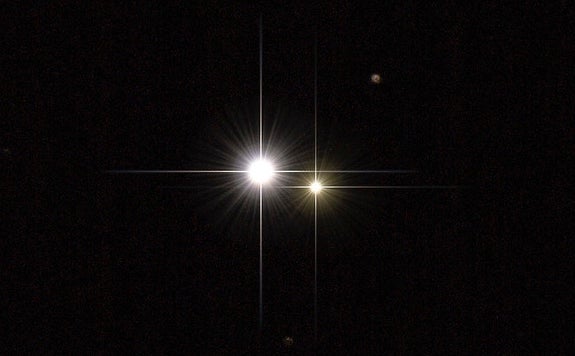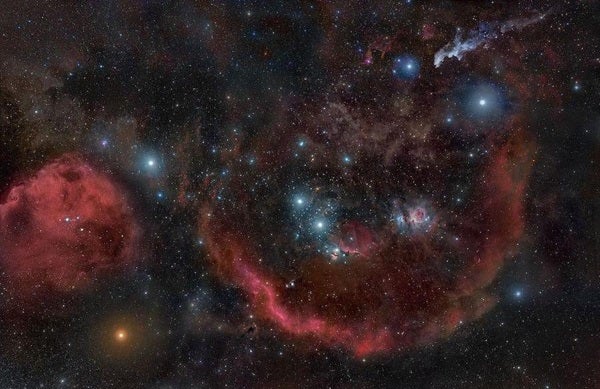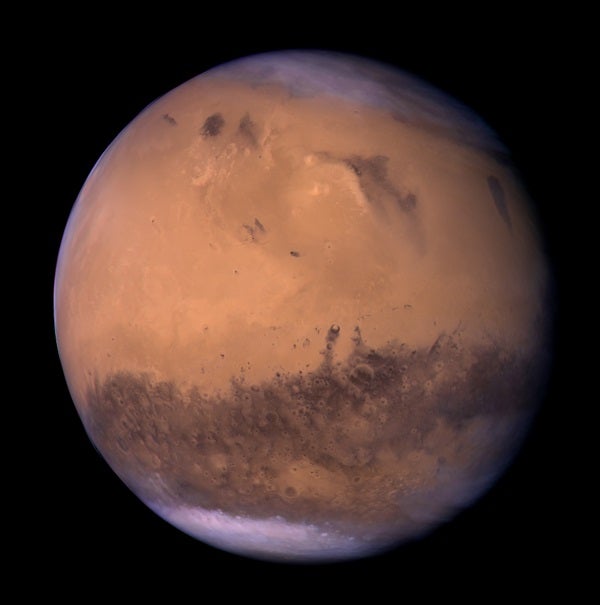A waxing Moon hangs out in Cancer the Crab all night. About 18° to its west is yellowish Pollux in Gemini, and nearly 4° farther is the whiter-hued Castor. The latter appears to the naked eye as a magnitude 1.6 star, but it is actually a six-star system. The two brightest stars, Castor A and B, can be separated with a small telescope. A third component, the dimmer Castor C, lies about 1.2′ away.
Saturday, March 7
Night owls can take a gander at one of the best globular clusters visible in the Northern Hemisphere. Messier 13, also known as the Hercules Cluster, rises above the horizon with its namesake constellation about 9 P.M. local time but is well poised for clearer viewing by midnight and into the early hours of the morning. This cluster of ancient stars circling our galaxy contains more than 100,000 members that combine to create its magnitude 5.8 glow.
Sunday, March 8
Venus and Uranus lie just over 2° apart in the evening sky. You can use Venus to easily find the ice giant by using binoculars or a telescope to locate a pair of 7th-magnitude stars about 1.2° to the lower left of Venus. Travel twice that distance in the same direction to reach brighter Uranus, glowing at magnitude 5.9.
Neptune is in conjunction with the Sun at 8 A.M. EDT. However, its position means it is lost from view in the bright glare of our star. It will make its way back to visibility by the end of next month.
For most of the United States and Canada, daylight saving time begins at 2 A.M. local time this morning. Set your clocks ahead one hour.
Monday, March 9
Venus passes 2° north of Uranus this morning at 11 A.M. EDT. The inferior planet will continue to move noticeably through Aries as March progresses, while the more distant ice giant moves only about 1° eastward during the month.
Mercury is stationary at 4 A.M. EDT. From here, it will move toward its greatest western elongation, which it will reach on the 23rd.
The Full Moon occurs at 1:48 P.M. EDT. This evening, our satellite rises in Virgo as the Sun is setting and will set in the morning around dawn. Full Moon is an excellent time to easily observe Luna with or without additional optical assistance; keep in mind that the Moon will appear especially bright through binoculars or a telescope. The Full Moon also washes out much of the sky, making this time best for observing planets and brighter stars, but poor for deep-sky objects such as galaxies and nebulae.
Tuesday, March 10
The Moon reaches perigee, its closest point to Earth in its orbit, at 2:30 A.M. EDT. At that time, it will sit 221,905 miles (357,121 kilometers) from our planet.
When the Full Moon occurs at perigee, it is sometimes called a supermoon by the media. Although this is an evocative name, the Full Moon will only appear about 7 percent larger than average, which is difficult if not impossible for observers to discern.
February is the perfect time to step outside and enjoy a classic celestial tableau. About an hour after sunset, look southwest to see Orion the Hunter aiming his bow west at Taurus the Bull. At Orion’s feet hides Lepus the Hare, and beside him is Canis Major, his faithful hunting dog. The Big Dog also contains Sirius, the brightest star in the northern sky, which shines at magnitude –1.4. Orion’s right shoulder is ruddy Betelgeuse, a red supergiant that has gained notoriety recently for inexplicably fading in brightness over the past four months. Now, it has begun to brighten again, and had bounced back by 10 percent from its dimmest point at the end of February. Taurus houses another of the sky’s famously red stars: magnitude 0.9 Aldebaran is easy to spot just beyond Orion’s bow.
Thursday, March 12
Mercury remains low and close to the horizon this month, but it is steadily growing easier to find in the morning sky. Rising an hour before sunrise, the tiny planet stands about 10° high and shines at magnitude 0.81 southeast of the Sun as our star peeks over the horizon. Its 9″-wide disc is nearly 31 percent illuminated.
Today marks the 165th anniversary of Percival Lowell’s birth in 1855. Lowell was one of many astronomers who believed Mars hosted canals constructed by native life forms for irrigation purposes. Although Mars does not have canals, you can observe the Red Planet that fascinated Lowell so in the last few hours before sunrise. By an hour before sunrise, Mars stands 17° above the horizon, glowing at magnitude 1.
Following a line east of the Red Planet, you’ll find first Jupiter, then Saturn. For an additional Lowell-themed target, pull out your telescope and search the sky roughly halfway between the two giant planets. There you may spot magnitude 14 Pluto, arguably the solar system’s most famous dwarf planet. It was Lowell’s study of the orbit of Uranus that caused him to propose the presence of an unknown planet outside of Neptune’s orbit. That prediction sparked the years-long search that ultimately culminated in the discovery of Pluto by Clyde Tombaugh on February 18, 1930, 14 years after Lowell’s death.

Our exclusive Sky Guide 2020 is now available! This free downloadable pamphlet contains a month-by-month rundown of 2020’s biggest celestial events, from Mars’ best opposition in years to the return of totality in South America this December. Check out Astronomy’s Sky Guide 2020 now!












